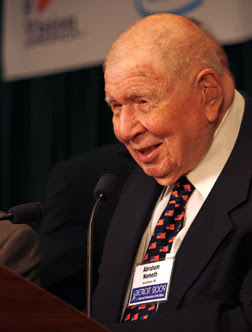Not a religious Jew, Harold Ramis did don a tallit and gave a terrific sermon on Rosh Hashanah at Aitz Hayim Center for Jewish Living a few years ago. Here are the videos of that presentation about Jewish creativity:
For many, Harold Ramis’ finest writing contribution was the 1993 classic Groundhog Day. In a talk at the Hudson Union Society in 2009, Ramis explained some of the allure behind Groundhog Day. While Zen Buddhists find it to be very Buddhist, Christians see the Christian metaphors in the film. The psychiatric community told Ramis that they thought the movie was a metaphor for psychoanalysis. At the 2:39 mark of this talk, Harold Ramis shares how there is a connection between Groundhog Day and the Torah. As a Jew, Ramis explains that Jews respond to the movie so well because the Torah is read anew every year and yet we see the same story with different meanings.


